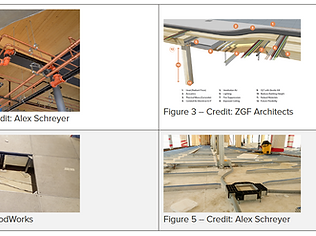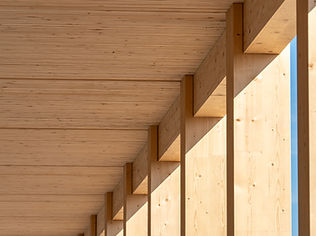MTTP Resource Library
This resource library compiles existing materials from established organizations and platforms that address the s identified in the Mass Timber Tipping Point project. We recognize and acknowledge that there are other excellent resource libraries in the mass timber space, including those maintained by organizations like WoodWorks, Think Wood, The Canadian Wood Council, The American Wood Council, Built by Nature, and the Washington Mass Timber Accelerator. This collection represents our lens and filter applied to resources from across the mass timber ecosystem, organized specifically around the 25 s and recommendations outlined in this report.

2025 International Mass Timber Report
2025
Trifecta Collective (with editorial contributions from industry leaders)

Accommodating MEP in Exposed Mass Timber Buildings
2022
WoodWorks

American Wood Council Code Adoption Map
Regularly updated
American Wood Council (AWC)

Architectural Finishes and Mass Timber: A Primer
2024
WoodWorks

B.C.'s Wood First Program
Regularly updated
Province of British Columbia (through Forestry Innovation Investment)

Bakers Place Case Study
2024
The Neutral Project LLC (with USDA Wood Innovations Grant funding)

Boston Mass Timber Accelerator
2024
Boston Planning & Development Agency (BPDA) and Boston Society for Architecture (BSA)

Buy Clean California Publishes Embodied Carbon Limits
2021
Mantle (Mantle Developments)

CLT Layups and Basis of Design for Gravity Load Applications
2022
WoodWorks

Canadian CLT Handbook
2019
FPInnovations

Carbon Credits for Mass Timber Construction
2023
USDA Forest Products Laboratory

Commercial Timber Guidebook
2024
Built By Nature / Timber Development UK

Corgan's Carbon Calculator
2025
Corgan

Delegated Design vs. Design Assist for Mass Timber Structures:
2025
WoodWorks

Design for Two-Way Spanning Cross-Laminated Timber - Considerations for utilizing CLT in two-way spanning applications.
2025
WoodWorks

DowelLam Design Guide - Dowel Laminated Timber (DLT)
2025
StructureCraft (DowelLam Division)

Exterior Walls in Mass Timber Buildings
2025
WoodWorks

Fire Design of Mass Timber Members: Code Applications, Construction Types and Fire Ratings
2021
WoodWorks

Freres Mass Ply Design & Construction Guide
2019
Freres Engineered Wood

Getting to Yes: Making Effective Use of the Alternate Means Process
2021
WoodWorks - Wood Products Council

How to Include Biogenic Carbon in an LCA
2023
WoodWorks

Insurance for Mass Timber Construction: Assessing Risk and Providing Answers
2024
WoodWorks - Wood Products Council

Kalesnikoff Design Guide
2022
Kalesnikoff Mass Timber Inc.

Mapping Mass Timber Projects in Design & Constructed
Regularly updated
WoodWorks - Wood Products Council

Mass Timber Business Case Studies
2023
WoodWorks

Mass Timber Cost and Design Optimization Checklists
2022
WoodWorks

Mass Timber Installation Training Curriculum
Regularly updated
WoodWorks

Mass Timber LookBook
2024
Think Wood (funded by the Softwood Lumber Board)

Mass Timber: The Optimal Solution for Multi-Family High-Rise Construction
2024
WoodWorks

Minoro
Regularly updated
Grimshaw (in partnership with World Business Council for Sustainable Development)

Nordic Structures Technical Documents Library
Regularly updated
Nordic Structures

Primer on Project Delivery
2019
Associated General Contractors of America (AGC) & American Institute of Architects (AIA)

Resources for Designing and Building with Wood: Continuing Education for Architects
Regularly updated
Think Wood

Specifying Appearance for CLT, NLT and Glulam
2024
WoodWorks

A Developer’s Guide to Mass Timber
2024
The Neutral Project LLC

Acoustics and Mass Timber: Room-to-Room Noise Control
2023
WoodWorks

American Wood Council Design and Construction Manuals
Regularly updated
American Wood Council (AWC)

Athena Sustainable Materials Institute LCA Software Suite
Regularly updated
Athena Sustainable Materials Institute

BC Mass Timber Demonstration Program (MTDP)
Regularly updated
Province of British Columbia (through Forestry Innovation Investment)

Biogenic Carbon Accounting in WBLCA Tools
2024
WoodWorks

Build in Wood Policy Catalogue
2024
Build-in-Wood Project (EU Horizon 2020 program) / Danish Technological Institute

CLT Diaphragm Design Guide
2023
WoodWorks

CLT Shear Wall Options in the US
2025
WoodWorks

Canadian Mass Timber Roadmap
2024
The Transition Accelerator, Forest Products Association of Canada (FPAC), Canadian Wood Council (CWC), and Energy Futures Lab (EFL)

CodeMaster Reference - Design of Tall Mass Timber
2021
S. K. Ghosh Associates LLC

Comparing Tall Timber Building Size Limits to Other Construction Types
2022
WoodWorks

Creating Efficient Structural Grids in Mass Timber Buildings
2024
WoodWorks

Demonstrating Fire-Resistance Ratings for Mass Timber Elements in Tall Wood Structures
2022
WoodWorks

Designing Mass Timber Floor Assemblies for Acoustics
2022
WoodWorks

Element5 Design Guide
2022
Element5 Limited Partnership

Fast+Epp Design Apps
2024
Fast + Epp Structural Engineers

Forest Supply Chain Analysis Series
2024
Olifant

Generate Platform
Regularly updated
Generate

Green Construction through Wood (GCWood) Program
Regularly updated
Natural Resources Canada (NRCan) - Canadian Forest Service

How to Successfully Cost Manage a Mass Timber Project
2024
WoodWorks

Integrated Project Delivery For Public and Private Owners
2015
Associated General Contractors of America (AGC)

Key Design Considerations for Mass Timber Projects
2024
WoodWorks

Mass Timber AMM Guide
2025
American Wood Council (AWC)

Mass Timber Comparative Life Cycle Assessment Series
2024
WoodWorks

Mass Timber Design Manual – Volume 2
2022
WoodWorks and Think Wood

Mass Timber Insurance Playbook – U.S. Edition
2024
WoodWorks

Mass Timber Project Questionnaire for Builder’s Risk Insurance
2022
WoodWorks

Meeting Sustainability Objectives with Wood Buildings
2023
WoodWorks
New Mass Timber Act to Target All Federal Buildings — US Congress
2024
Wood Central

One Click LCA
Regularly updated
One Click LCA (Bionova Ltd)

Quebec's Wood Construction Innovation Program
Ongoing program (current)
Government of Quebec

Shaft Wall Requirements for Tall Mass Timber Buildings
2022
WoodWorks

A Guideline for Insuring Timber in Canada
2022
WoodWorks / Canadian Wood Council

Alternative Solutions Guide (CWC)
2025
WoodWorks / Canadian Wood Council

American Wood Council Wood Sourcing Tool
2024
American Wood Council (AWC)

Aureus Earth's Carbon Financing
No date
Aureus Earth

BEAM Estimator
2022
Builders for Climate Action

Biophilic Design LookBook
2022
Think Wood (in partnership with WoodWorks - Wood Products Council)

Building Trust for a Stronger Construction Industry
2025
A. Hoots et al. (ResearchGate publication)

CLT Diaphragm Design for Wind and Seismic Resistance
2022
WoodWorks

Calculating the Carbon Stored in Wood Products
2025
WoodWorks

Carbon Accounting Tools for Structural Systems
2025
WoodWorks

Commercial Projects That Pencil Out
2024
Think Wood (funded by the Softwood Lumber Board)

Considerations & Worksheet for Structural WBLCA of Mass Timber Buildings
2024
WoodWorks

Current EPDs for Wood Products
2025
WoodWorks

Denver Green Code
2022
City and County of Denver

Developing a Functionally Equivalent Design for Comparative WBLCA
2024
WoodWorks

Embodied Carbon in Construction Calculator (EC3)
2019
Building Transparency (developed initially by Skanska and C Change Labs, incubated by Carbon Leadership Forum)

Fire Design of Gypsum Wall Board over Mass Timber
2025
WoodWorks

Free Webinars Showcasing Wood And Mass Timber Construction Topics
Regularly updated
WoodWorks

Georgia Mass Timber Accelerator
Regularly updated
Georgia Forestry Foundation (GFF) in partnership with USDA Forest Service and Softwood Lumber Board

How Can a Developer/Owner Get Started with Mass Timber?
2022
WoodWorks

How to Use Environmental Product Declarations
2024
WoodWorks

Introduction to Whole Building Life Cycle Assessment: The Basics
2024
WoodWorks

LCA and Timber Optimization
2018
Carbon Leadership Forum

Mass Timber Building Science Primer
2021
Mass Timber Institute (University of Toronto)

Mass Timber Construction Success Checklist
No date
WoodWorks BC in partnership with Seagate Mass Timber

Mass Timber Fire & Acoustic Database
Regularly updated
WoodWorks

Mass Timber Insurance Strategy Roadmap: 2025-2030
2025
WoodWorks - Wood Products Council (with FieldEdge)

Mass Timber in Affordable Multi-Family Housing
2024
WoodWorks

Mercer Mass Timber Design Guide
2024
Mercer Mass Timber (MMT)

New York Timber Studio
Regularly updated
New York City Economic Development Corporation (NYCEDC) and Newlab in collaboration with Mayor's Office of Climate and Environmental Justice

Online Mass Timber And Wood Sustainability Resources
Regularly updated
WoodWorks

Quebec's Wood Integration Policy in Construction
Ongoing policy (current)
Government of Quebec

Smartlam North America Design Guide
2025
Smartlam North America